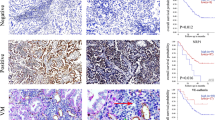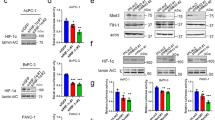Abstract
Pancreatic cancer is one of the most lethal malignancies due to its aggressive growth and rapid development of distant metastases. In this context, mucin 1 (MUC1) overexpression and hypoxia are frequently observed events. However, their functional relationship remains largely unknown. This study provides evidence that MUC1 is overexpressed by hypoxia and contributes to hypoxia-driven angiogenesis. Using the conditioned medium obtained from hypoxia-stressed AsPC1 cells treated with MUC1 siRNAs, we demonstrated that MUC1 enhanced the endothelial tube formation, proliferation and migration ability, which induced by hypoxia-conditioned medium (HCM). In addition, MUC1 was significantly induced by hypoxia, especially in the pancreatic cancer cells derived from metastatic tumors (AsPC1, HPAF2 or Capan1), and MUC1-cytoplasmic tail (MUC1-CT) accumulated in the nucleus under hypoxia. As noted in a previous report, MUC1-CT was recruited to genomic regions upstream of the connective tissue growth factor (CTGF) accompanied with β-catenin and p53, resulting in the hypoxic induction of CTGF. Moreover, hypoxia-induced MUC1 partially regulated two other hypoxia-inducible proangiogenic factors including vascular endothelial growth factor-A and platelet-derived growth factor-B. The neutralization assay revealed that endothelial tube formation induced by HCM was clearly suppressed by antibodies against these three factors, suggesting the importance of these factors in hypoxia-driven angiogenesis. In summary, this is the first report demonstrating a pivotal role of MUC1 in controlling the hypoxia-driven angiogenesis through the regulation of multiple proangiogenic factors in pancreatic cancer. Our findings provide the novel insights into the understanding of complex interactions between pancreatic cancer cells and tumor microenvironments.
This is a preview of subscription content, access via your institution
Access options
Subscribe to this journal
Receive 50 print issues and online access
$259.00 per year
only $5.18 per issue
Buy this article
- Purchase on Springer Link
- Instant access to full article PDF
Prices may be subject to local taxes which are calculated during checkout






Similar content being viewed by others
References
Hidalgo M . Pancreatic cancer. N Engl J Med 2010; 362: 1605–1617.
Harris AL . Hypoxia—a key regulatory factor in tumour growth. Nat Rev Cancer 2002; 2: 38–47.
Semenza GL . Angiogenesis in ischemic and neoplastic disorders. Annu Rev Med 2003; 54: 17–28.
Brown JM, Wilson WR . Exploiting tumour hypoxia in cancer treatment. Nat Rev Cancer 2004; 4: 437–447.
Chang Q, Jurisica I, Do T, Hedley DW . Hypoxia predicts aggressive growth and spontaneous metastasis formation from orthotopically grown primary xenografts of human pancreatic cancer. Cancer Res 2011; 71: 3110–3120.
Lu X, Kang Y . Hypoxia and hypoxia-inducible factors: master regulators of metastasis. Clin Cancer Res 2010; 16: 5928–5935.
Vaupel P, Mayer A . Hypoxia in cancer: significance and impact on clinical outcome. Cancer Metastasis Rev 2007; 26: 225–239.
Dewhirst MW, Cao Y, Moeller B . Cycling hypoxia and free radicals regulate angiogenesis and radiotherapy response. Nat Rev Cancer 2008; 8: 425–437.
Keith B, Johnson RS, Simon MC . HIF1alpha and HIF2alpha: sibling rivalry in hypoxic tumour growth and progression. Nat Rev Cancer 2012; 12: 9–22.
Macao B, Johansson DG, Hansson GC, Hard T . Autoproteolysis coupled to protein folding in the SEA domain of the membrane-bound MUC1 mucin. Nat Struct Mol Biol 2006; 13: 71–76.
Levitin F, Stern O, Weiss M, Gil-Henn C, Ziv R, Prokocimer Z et al. The MUC1 SEA module is a self-cleaving domain. J Biol Chem 2005; 280: 33374–33386.
Bhaskar KR, Garik P, Turner BS, Bradley JD, Bansil R, Stanley HE et al. Viscous fingering of HCl through gastric mucin. Nature 1992; 360: 458–461.
Linden SK, Sutton P, Karlsson NG, Korolik V, McGuckin MA . Mucins in the mucosal barrier to infection. Mucosal Immunol 2008; 1: 183–197.
Yonezawa S, Higashi M, Yamada N, Yokoyama S, Kitamoto S, Kitajima S et al. Mucins in human neoplasms: clinical pathology, gene expression and diagnostic application. Pathol Int 2011; 61: 697–716.
Hollingsworth MA, Swanson BJ . Mucins in cancer: protection and control of the cell surface. Nat Rev Cancer 2004; 4: 45–60.
Kufe DW . Mucins in cancer: function, prognosis and therapy. Nat Rev Cancer 2009; 9: 874–885.
Carson DD . The cytoplasmic tail of MUC1: a very busy place. Sci Signal 2008; 1: pe35.
Aubert S, Fauquette V, Hemon B, Lepoivre R, Briez N, Bernard D et al. MUC1, a new hypoxia inducible factor target gene, is an actor in clear renal cell carcinoma tumor progression. Cancer Res 2009; 69: 5707–5715.
Mikami Y, Hisatsune A, Tashiro T, Isohama Y, Katsuki H . Hypoxia enhances MUC1 expression in a lung adenocarcinoma cell line. Biochem Biophys Res Commun 2009; 379: 1060–1065.
Kaira K, Nakagawa K, Ohde Y, Okumura T, Takahashi T, Murakami H et al. Depolarized MUC1 expression is closely associated with hypoxic markers and poor outcome in resected non-small cell lung cancer. Int J Surg Pathol 2011; 20: 223–232.
Zanetti JS, Soave DF, Oliveira-Costa JP, da Silveira GG, Ramalho LN, Garcia SB et al. The role of tumor hypoxia in MUC1-positive breast carcinomas. Virchows Arch 2011; 459: 367–375.
Kaira K, Okumura T, Nakagawa K, Ohde Y, Takahashi T, Murakami H et al. MUC1 Expression in pulmonary metastatic tumors: a comparison of primary lung cancer. Pathol Oncol Res 2012; 18: 439–447.
Giatromanolaki A, Koukourakis MI, Sivridis E, O'Byrne K, Cox G, Thorpe PE et al. Coexpression of MUC1 glycoprotein with multiple angiogenic factors in non-small cell lung cancer suggests coactivation of angiogenic and migration pathways. Clin Cancer Res 2000; 6: 1917–1921.
Papadopoulos I, Sivridis E, Giatromanolaki A, Koukourakis MI . Tumor angiogenesis is associated with MUC1 overexpression and loss of prostate-specific antigen expression in prostate cancer. Clin Cancer Res 2001; 7: 1533–1538.
Behrens ME, Grandgenett PM, Bailey JM, Singh PK, Yi CH, Yu F et al. The reactive tumor microenvironment: MUC1 signaling directly reprograms transcription of CTGF. Oncogene 2010; 29: 5667–5677.
Bennewith KL, Huang X, Ham CM, Graves EE, Erler JT, Kambham N et al. The role of tumor cell-derived connective tissue growth factor (CTGF/CCN2) in pancreatic tumor growth. Cancer Res 2009; 69: 775–784.
Shimo T, Kubota S, Kondo S, Nakanishi T, Sasaki A, Mese H et al. Connective tissue growth factor as a major angiogenic agent that is induced by hypoxia in a human breast cancer cell line. Cancer Lett 2001; 174: 57–64.
Sahraei M, Roy LD, Curry JM, Teresa TL, Nath S, Besmer D et al. MUC1 regulates PDGFA expression during pancreatic cancer progression. Oncogene 2012; 31: 4935–4945.
Roy LD, Sahraei M, Subramani DB, Besmer D, Nath S, Tinder TL et al. MUC1 enhances invasiveness of pancreatic cancer cells by inducing epithelial to mesenchymal transition. Oncogene 2011; 30: 1449–1459.
Yao M, Zhang W, Zhang Q, Xing L, Xu A, Liu Q et al. Overexpression of MUC1 enhances proangiogenic activity of non-small-cell lung cancer cells through activation of Akt and extracellular signal-regulated kinase pathways. Lung 2011; 189: 453–460.
Woo JK, Choi Y, Oh SH, Jeong JH, Choi DH, Seo HS et al. Mucin 1 enhances the tumor angiogenic response by activation of the AKT signaling pathway. Oncogene 2011; 31: 2187–2198.
Yin L, Kharbanda S, Kufe D . Mucin 1 oncoprotein blocks hypoxia-inducible factor 1alpha activation in a survival response to hypoxia. J Biol Chem 2007; 282: 257–266.
Chu CY, Chang CC, Prakash E, Kuo ML . Connective tissue growth factor (CTGF) and cancer progression. J Biomed Sci 2008; 15: 675–685.
Dornhofer N, Spong S, Bennewith K, Salim A, Klaus S, Kambham N et al. Connective tissue growth factor-specific monoclonal antibody therapy inhibits pancreatic tumor growth and metastasis. Cancer Res 2006; 66: 5816–5827.
Higgins DF, Biju MP, Akai Y, Wutz A, Johnson RS, Haase VH . Hypoxic induction of Ctgf is directly mediated by Hif-1. Am J Physiol Renal Physiol 2004; 287: F1223–F1232.
Sakamoto H, Yonezawa S, Utsunomiya T, Tanaka S, Kim YS, Sato E . Mucin antigen expression in gastric carcinomas of young and old adults. Hum Pathol 1997; 28: 1056–1065.
Furukawa T, Duguid WP, Rosenberg L, Viallet J, Galloway DA, Tsao MS . Long-term culture and immortalization of epithelial cells from normal adult human pancreatic ducts transfected by the E6E7 gene of human papilloma virus 16. Am J Pathol 1996; 148: 1763–1770.
Ouyang H, Mou L, Luk C, Liu N, Karaskova J, Squire J et al. Immortal human pancreatic duct epithelial cell lines with near normal genotype and phenotype. Am J Pathol 2000; 157: 1623–1631.
Yonezawa S, Kitajima S, Higashi M, Osako M, Horinouchi M, Yokoyama S et al. A novel anti-MUC1 antibody against the MUC1 cytoplasmic tail domain: use in sensitive identification of poorly differentiated cells in adenocarcinoma of the stomach. Gastric Cancer (e-pub ahead of print 12 January 2012; doi:10.1007/S10120-011-0125-2).
Kitamoto S, Yokoyama S, Higashi M, Yamada N, Matsubara S, Takao S et al. Expression of MUC17 is regulated by HIF1alpha-mediated hypoxic responses and requires a methylation-free hypoxia responsible element in pancreatic cancer. PloS one 2012; 7: e44108.
Acknowledgements
This work was supported by the Princess Takamastu Cancer Research Fund (11-24319; S Yonezawa); by the Scientific Research on Priority Areas 20014022 and Scientific Research (B) 23390085 (S Yonezawa) and Scientific Research (C) 20590399 (M Higashi) grants from the Ministry of Education, Science, Sports, Culture and Technology, Japan; by an International Educational Research Support Project for Islands, Environment and Medicine (S Yokoyama); by a JSPS Fellowship Grant-in-Aid (no. 239349; S Kitamoto); by a Pancreas Reserch Foundation of Japan (S Yokoyama) and Kodama Memorial Foundation, Japan (S Kitamoto, S Yokoyama and M Higashi). We would like to express our gratitude to Dr Ming-Sound Tsao for providing us with the immortalized human pancreatic duct epithelial cells. We also thank Mses Izumi Houjou and Yukari Nishimura for their excellent technical assistance.
Author information
Authors and Affiliations
Corresponding author
Ethics declarations
Competing interests
The authors declare no conflict of interest.
Additional information
Supplementary Information accompanies the paper on the Oncogene website
Rights and permissions
About this article
Cite this article
Kitamoto, S., Yokoyama, S., Higashi, M. et al. MUC1 enhances hypoxia-driven angiogenesis through the regulation of multiple proangiogenic factors. Oncogene 32, 4614–4621 (2013). https://doi.org/10.1038/onc.2012.478
Received:
Revised:
Accepted:
Published:
Issue Date:
DOI: https://doi.org/10.1038/onc.2012.478
Keywords
This article is cited by
-
Bioinformatics analysis of ferroptosis-related genes and immune cell infiltration in non-alcoholic fatty liver disease
European Journal of Medical Research (2023)
-
Sensitive and selective detection of Mucin1 in pancreatic cancer using hybridization chain reaction with the assistance of Fe3O4@polydopamine nanocomposites
Journal of Nanobiotechnology (2022)
-
Exosomes: the key of sophisticated cell–cell communication and targeted metastasis in pancreatic cancer
Cell Communication and Signaling (2022)
-
The multifaceted role of MUC1 in tumor therapy resistance
Clinical and Experimental Medicine (2022)
-
Crosstalk between MUC1 and VEGF in angiogenesis and metastasis: a review highlighting roles of the MUC1 with an emphasis on metastatic and angiogenic signaling
Cancer Cell International (2021)



